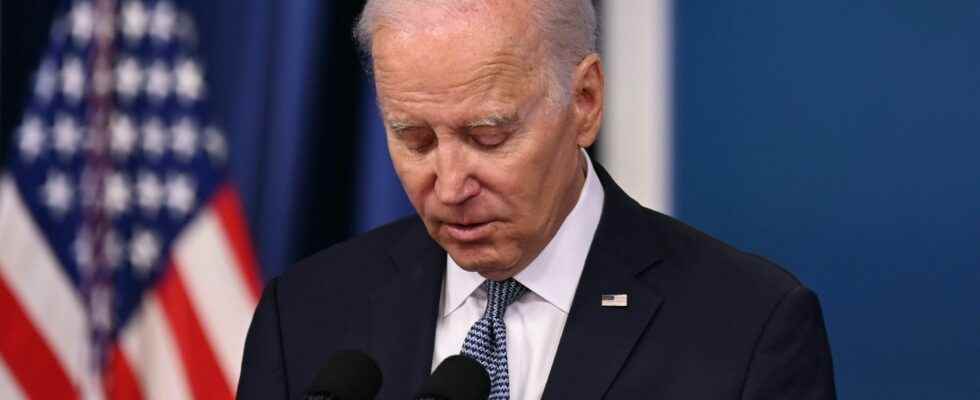As on many occasions since the 1960s, the United States has reached its debt ceiling. The Republicans are using this economic event to force the Democrats to negotiate on social spending, and are currently blocking any negotiation on raising the ceiling. If this political battle fails, economists fear a default that could destroy the economy of the richest country in the world, and cause a global financial crisis.
What’s going on with US debt?
Thursday, January 19, 2023, the United States reached its debt ceiling, the maximum level of what it can borrow to run the country. The current limit set at 31,000 billion dollars has just been exceeded. This situation is by no means exceptional: the US debt ceiling has been changed many times since 1960 – Congress has full powers to raise it when necessary.
But as often, it is a showdown between Democrats and Republicans that threatens the functioning of the country. The very thin Republican majority in the House of Representatives refuses to vote for this increase, because it wants to take this opportunity to put pressure on the Democrats and obtain several spending cuts, in particular on the social measures generated by the application of Joe’s program Biden.
This political battle between the two camps has resurfaced regularly for the past thirty years. This time, however, Congress is not only deeply divided, but the Republican party is itself held by the throats of extreme factions, including a parliamentary group called the “Freedom Caucus.” Arch-conservative, anti-fiscal (for example, he is firmly opposed to the Obamacare health insurance system) and sometimes libertarian, the latter could refuse to give in to negotiations with the Democrats.
What are the dangers in case of non-payment?
Nobody knows exactly what would happen, because the United States has never really reached the stage of default before. But Janet Yellen, the US Treasury Secretary, spoke from Dakar on Friday January 20 to warn against what she believes could become, if the political negotiations do not succeed, a “global economic crisis”.
Initially, a default would “certainly cause a recession in the United States”, due to “the inability to make payment, whether of our debt obligations, to the beneficiaries social spending or our military, she estimated on CNN. “Our borrowing costs would go up, and every American would see their own people follow the same trend,” she said, saying “a lot of Americans would lose their jobs.” A plunge on Wall Street and a loss of confidence in the dollar, used around the world as a stable transaction currency, could thus cause the recession to spread, as it did in 2008.
In the fall of 2011 under the presidency of Barack Obama, the imminent threat of a default on the payment of the debt (which ultimately did not occur) was enough to send the financial markets plunging and to lower the rating assigned to the United States by the S&P agency. From “AAA”, the highest possible rating, it had then risen to “AA+”. This “degradation reflects our view that the effectiveness, stability and predictability of American politics and political institutions have been weakened,” the agency said at the time. The United States have since never recovered their triple A.
What is the solution ?
To be able to meet the financial commitments and obligations already authorized by Congress, without entering into imminent default, the US Treasury Secretary announced on Friday the implementation of “extraordinary measures”. That is, administrative sleight of hand that buys government time. The United States will for example stop – temporarily – payments to several retirement, health or disability funds for public officials and former military personnel, and set up “a period of suspension of debt issuance”. These combined measures should allow them to postpone the date on which they will enter into default until June 5. After that, it’s the big unknown.
The somewhat mystical “platinum coin” proposal has even resurfaced: some are proposing to have the Treasury mint a platinum coin worth $1 trillion, which would buy the government more time. But Janet Yellen rejected this unrealistic idea, which had already been put on the table and then dismissed many times since 2011 to avoid political negotiations.
The only long-term solution, therefore, lies in the negotiations which will have to take place between the Republicans and the Democrats in the House of Representatives before June 5, otherwise the American economy could collapse this summer.
Where are the negotiations?
In 2021, the last time the US hit the nation’s borrowing limit, the two parties reached a short-term deal to raise the debt ceiling by $2.5 trillion, two weeks from default. of payment.
This time, “speaker” Kevin McCarthy is demanding that Democrats grant Republicans cuts in public spending to win their support. “We need to change the way we spend money unnecessarily in this country, and we’re going to make sure that happens,” he said. On Friday, Jan. 20, President Joe Biden promised Republicans there would be “honest debates” about how to deal with the nation’s mounting debt. “I accept your invitation to sit down and discuss a responsible increase in the debt ceiling to address irresponsible public spending,” McCarthy replied afterwards, in a statement posted on Twitter.
Their meeting was confirmed in the evening by the White House, on a date for the moment unknown. “Raising the debt ceiling is not negotiable,” said White House spokeswoman Karine Jean-Pierre firmly, adding that “it is an obligation for this country and its leaders to avoid the economic chaos.”
